Newly-promoted Lens face a difficult challenge in their second fixture in Ligue 1 as they go up against defending champions Paris Saint-Germain. While Franck Haise was able to play his strongest squad in this fixture, Thomas Tuchel had a depleted squad with seven key players unavailable due to positive COVID-19 tests. The former Borussia Dortmund manager decided to give some of the promising youngsters and reserve players some game time in this game.
Jean-Louis Leca and co. suffered a defeat in their Ligue 1 premiere against a highly impressive Nice side and they’re looking to take advantage of Les Parisiens weakened squad to get their first three points. On the other side, PSG certainly wanted to begin their campaign with a strong start.
It would be interesting to look at how both teams fare against each other. We’re gonna take a look at both teams’ tactics in detail in this tactical analysis.
Lineups
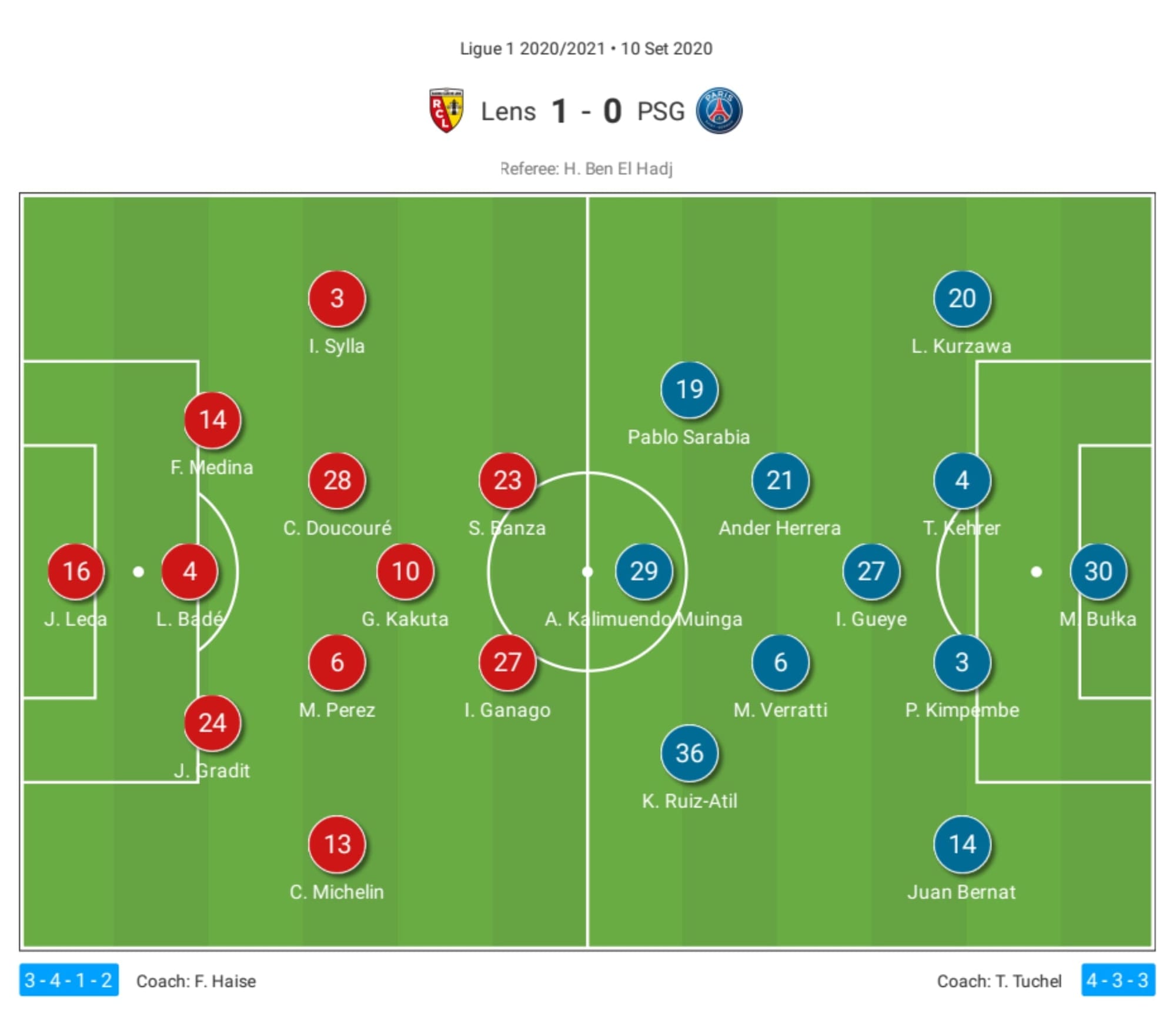
Haise deployed his team in his favoured 3-4-1-2 formation in this game. Some changes of personnel can be seen in the starting lineup. Leca started again between the sticks while the back three of Jonathan Gradit, Loïc Badé, and Facundo Medina remain unchanged. Manuel Perez replaced experienced midfielder Yannick Cahuzac in the central midfielder role in this game while Issiaga Sylla occupied the left wing-back berth to replace young prospect Ismaël Boura. Amiens loanee Gaël Kakuta and newly-signed striker Ignatius Ganago made the starting 11 again as an attacking midfielder and striker respectively. Meanwhile, Florian Sotoca was benched for this match with Simon Banza replacing him.
Paris Saint-Germain were without the likes of Kylian Mbappé, Neymar, Ángel Di María, Keylor Navas, Marquinhos, Leandro Paredes, and Mauro Icardi due to positive coronavirus tests. The fixture saw Tuchel deploy his team in a 4-3-3 formation. Arnaud Kalimuendo Muinga and Kays Ruiz-Atil make their senior debut, playing as a striker and as a left-winger respectively. Meanwhile, Polish goalkeeper who was signed from Chelsea last season, Marcin Bułka, played his second senior game with PSG.
Tuchel interestingly chose to play Layvin Kurzawa as a right-back in this game instead of starting Colin Dagba or Timothée Pembélé or moving Thilo Kehrer to right-back and playing Abdou Diallo as the centre-back.
Lens’ directness troubled Paris Saint-Germain
As expected, the home side have a tendency to be very direct and vertical-oriented in possession in contrast with the away side who tend to be more patient and possession-based. In this game, Lens showed high efficiency when in possession, preferring to move the ball around at a high pace and look to break forward as quickly as possible. Though they’re playing at such high tempo, Haise’s side never really looked like they’re rushing. The Lensois always looked calculated in their decision making and precise in their execution.
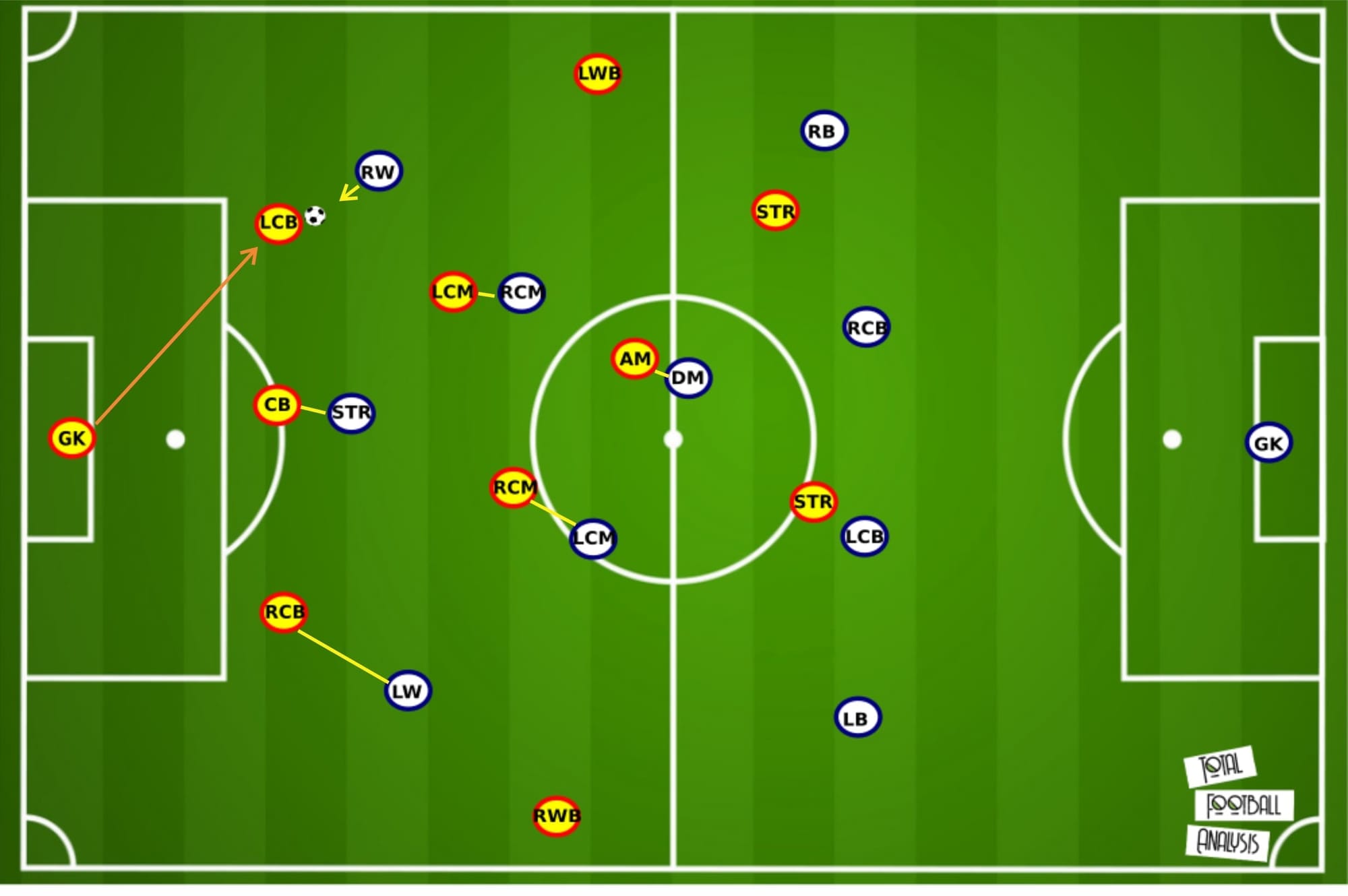
Above you can see Lens’ initial shape in the build-up as well as PSG’s pressing shape. In the early phase of build-up, the three Lens centre-backs wouldn’t spread very far, with the wide centre-backs tending to sit rather narrow. The two wing-backs sit high and wide, positioning themselves in the space between the opposing winger and full-back.
The two central midfielders actively move around the middle-third not only to escape from their opponents’ man-marking, but also to open up space and passing angles to help the centre-back progress the ball. Meanwhile, the attacking midfielder was quite flexible. He tended to stay high rather than drop deep to collect the ball, preferring to stay close to either of the two striker in order to potentially receive a layoff if a long ball is played. Meanwhile, if a ball is played towards the flank, he’d move wider in order to help create attacking overloads and again, to offer support.
Lens played with two strikers who seemed to receive different instructions in this game. Ganago tended to stay centrally and rarely drifted wide, preferring to play off the shoulder of PSG’s defender and make a lot of runs behind the defence. Meanwhile, Banza was much more active, drifted wide very often, and looked to occasionally get involved in the build-up by creating overloads and combining in the flanks. We’d take a further look at their different tendencies and their importance later in this tactical analysis.
Haise’s side usually started their build-up with a short distribution from the goalkeeper. However, with PSG pressing high and aggressively, forcing their way out by playing from the back might be too risky. Instead of forcing to play their way out of pressure from the back with short passes, Lens wouldn’t hesitate to play long passes towards their tall strikers and try to win the second ball or counterpress if the ball was won by PSG.
As can be seen above, PSG defended in a 4-3-3 shape. They looked to impose a high defensive block and press high up the pitch as they usually do. They seem to use a mix of zonal and man-oriented approach in defence.
PSG’s first line of pressure looked to put pressure on the three Lens centre-backs. While the lone striker mainly looked to man-mark the middle centre-back tightly, the two wingers have to focus on both pressing the wide centre-backs as well as putting the Lens wing-backs in their shadow cover.
PSG wouldn’t allow their opposition any chance of progression through the middle. Aside from employing a man-oriented marking in the second line in order to block the opposing centre-backs access to their midfielders, PSG’s vertically compact and narrow shape allow them to quickly collapse onto the ball and swarm their opposition if the ball is played into their central pressing traps.
Lens, however, managed to find a way to easily get past the PSG’s high pressure and quickly break forward. With space scarcely available in the middle, Lens would look to focus their attacks on the flank.
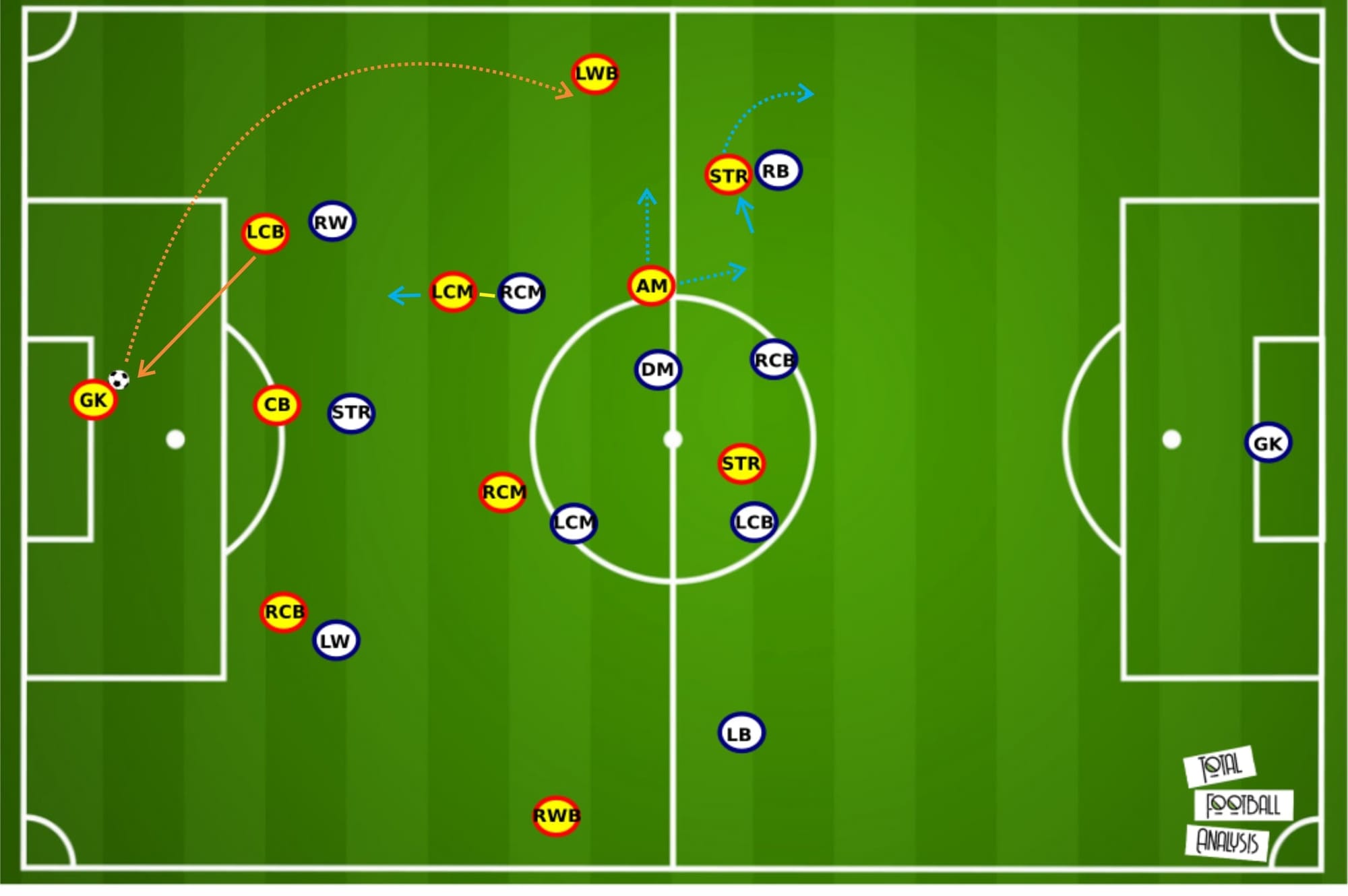
Above you can see Lens’ passing and movement pattern in order to exit PSG’s pressure and break forward. In the image above, the left centre-back received the ball from the goalkeeper but with all the near options being marked tightly, he played the ball back to the goalkeeper. The backpass from the left centre-back prompted PSG to push forward and pile more pressure. The goalkeeper would then immediately play the ball towards the left wing-back who’s free near the halfway line.
What’s interesting from this pattern is that normally, PSG’s right-back would immediately close down the Lens left wing-back upon seeing the pass being played towards him. However, as you can see above, he’s being occupied by Lens’ striker who moved outwards, hence why the PSG right-back decided not to jump out to press.
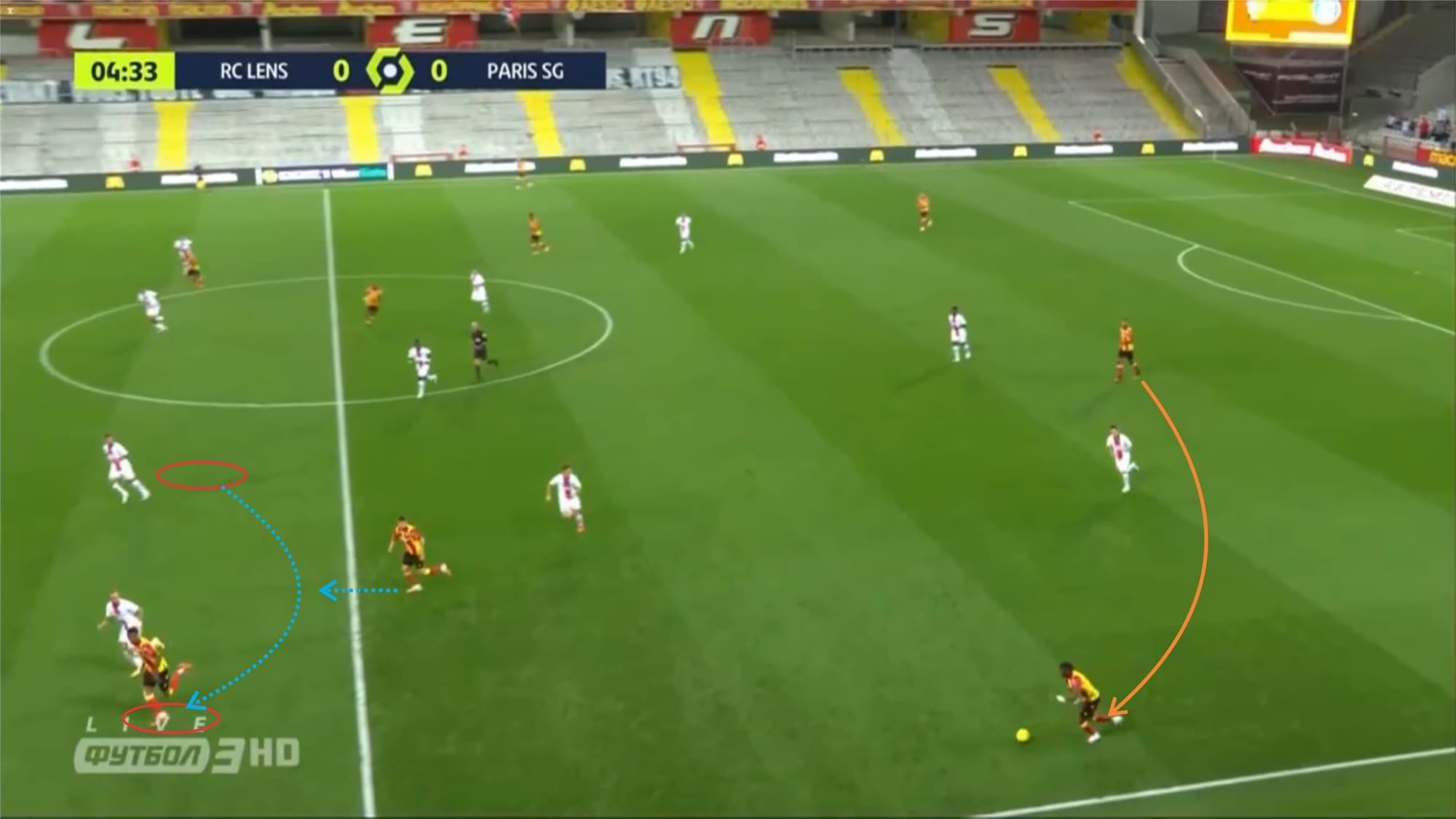
Occasionally, Lens managed to easily bypass PSG’s first line of pressure and play the ball towards their wing-back. This usually happened because of the winger’s poor angle of approach when pressing which left too much space open for Lens’ centre-back to pass the ball towards the wing-back as you can see in the image above.
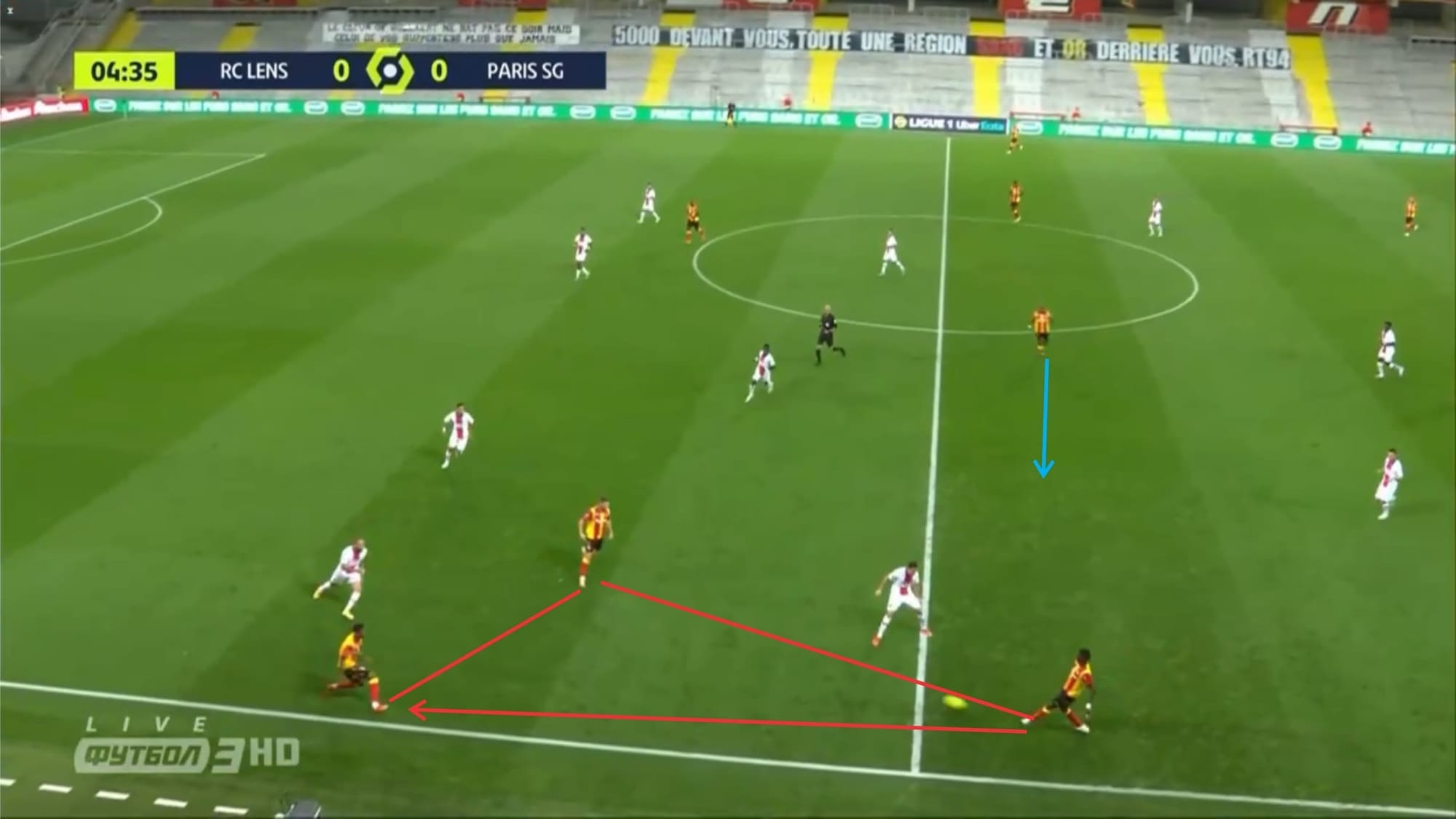
Lens tended to create passing triangles on the flank as you can see in the image above. Lens central midfielders tended to move wider and occupy the half-space if the ball was on their side. The attacking midfielder would also look to move closer to the man in possession in order to help create overload and offer support. As can be seen above, Banza was often seen drifting wide and get involved in the flank while Ganago stayed in the centre.
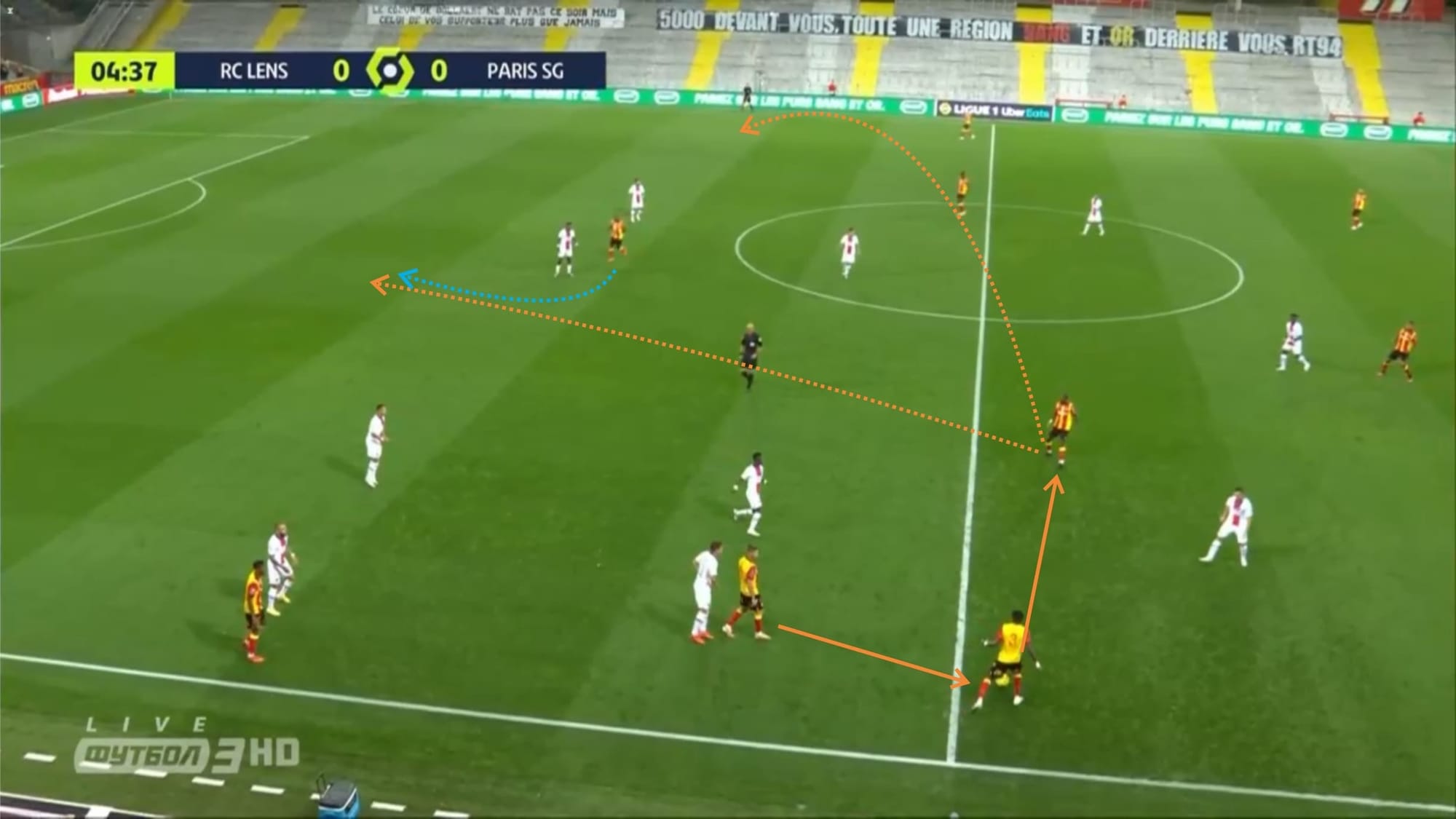
Lens always looked to exploit PSG’s high and compact defence. With both wing-backs always looking to sit high and wide and Ganago constantly looking to make runs in behind the defence, the playmakers always have options to either switch the ball towards the other flank/underloaded area or try a killer pass into space behind PSG’s defenders as can be seen in the image above.
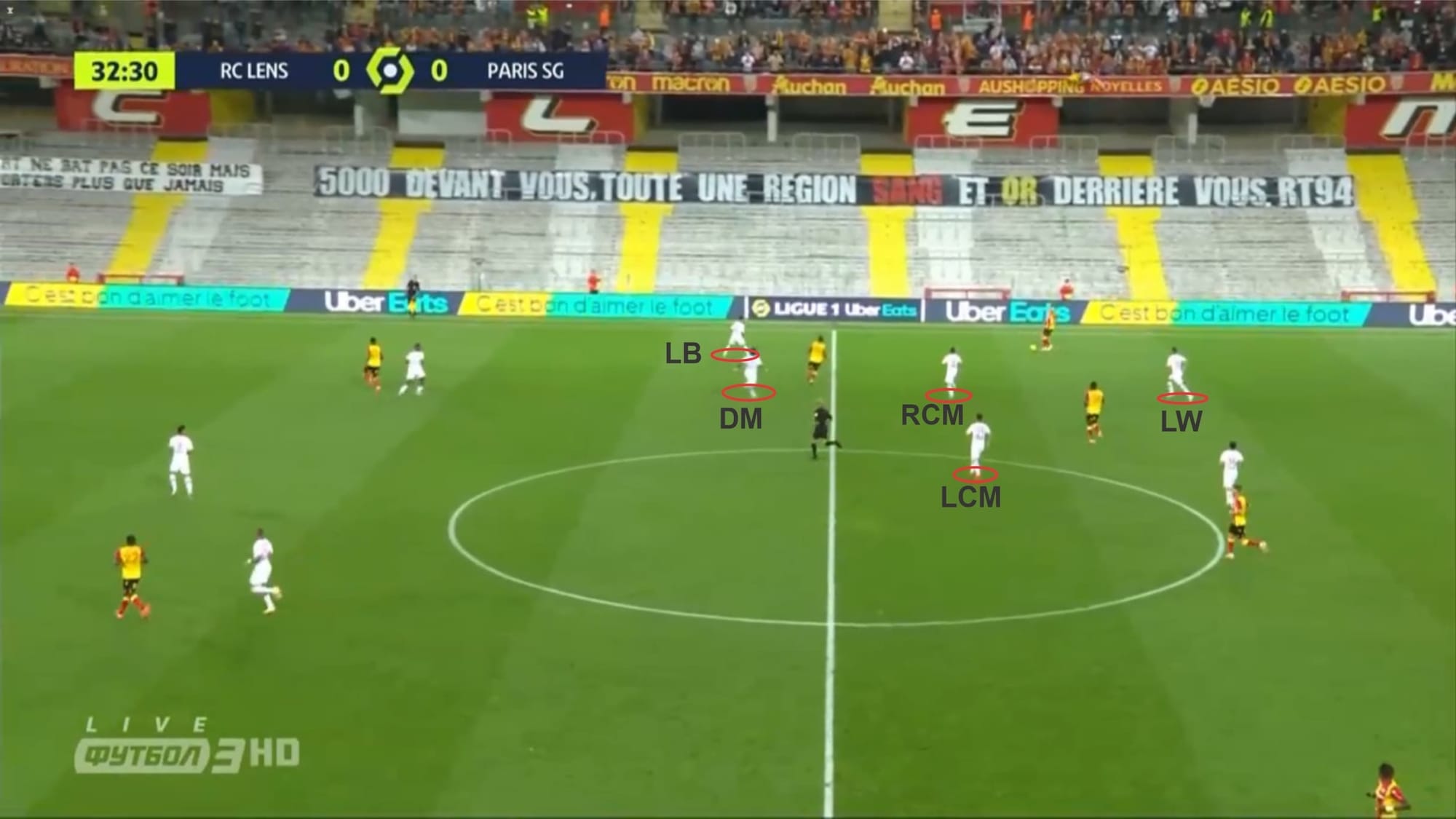
PSG were quite disciplined in this particular match. If the ball is moved wide, Tuchel’s side would quickly shift their block and concentrate their players in that particular area in order to create a defensive overload and isolate the opposing ball carrier as can be seen in the image above. If the ball is switched towards the opposite flank, they’ll quickly move their block across the field.
Paris Saint-Germain struggling to break Lens’ aggressive defence
As predicted, Paris Saint-Germain preferred a more possession-based approach. They were patient and aimed to work the ball around in order to create an opening and penetrate Lens’ defence. Lens, however, adopted a no-nonsense approach against Les Parisiens. They were very aggressive, intense, disciplined, and well-organized in defence, rarely giving their opposition any chance of scoring a goal.
As usual, PSG relied on fluid and flexible positioning and movements in order to disrupt the opposing team’s defensive structure as well as create positional advantages for themselves. PSG, however, were not as fluid as usual. Without the presence of Neymar, Mbappé, Icardi, and Di María, they looked all over the place in attack. They were unable to exploit spaces in between the lines in central areas as they usually like to do and they’re struggling to create any breakthrough in advanced areas.
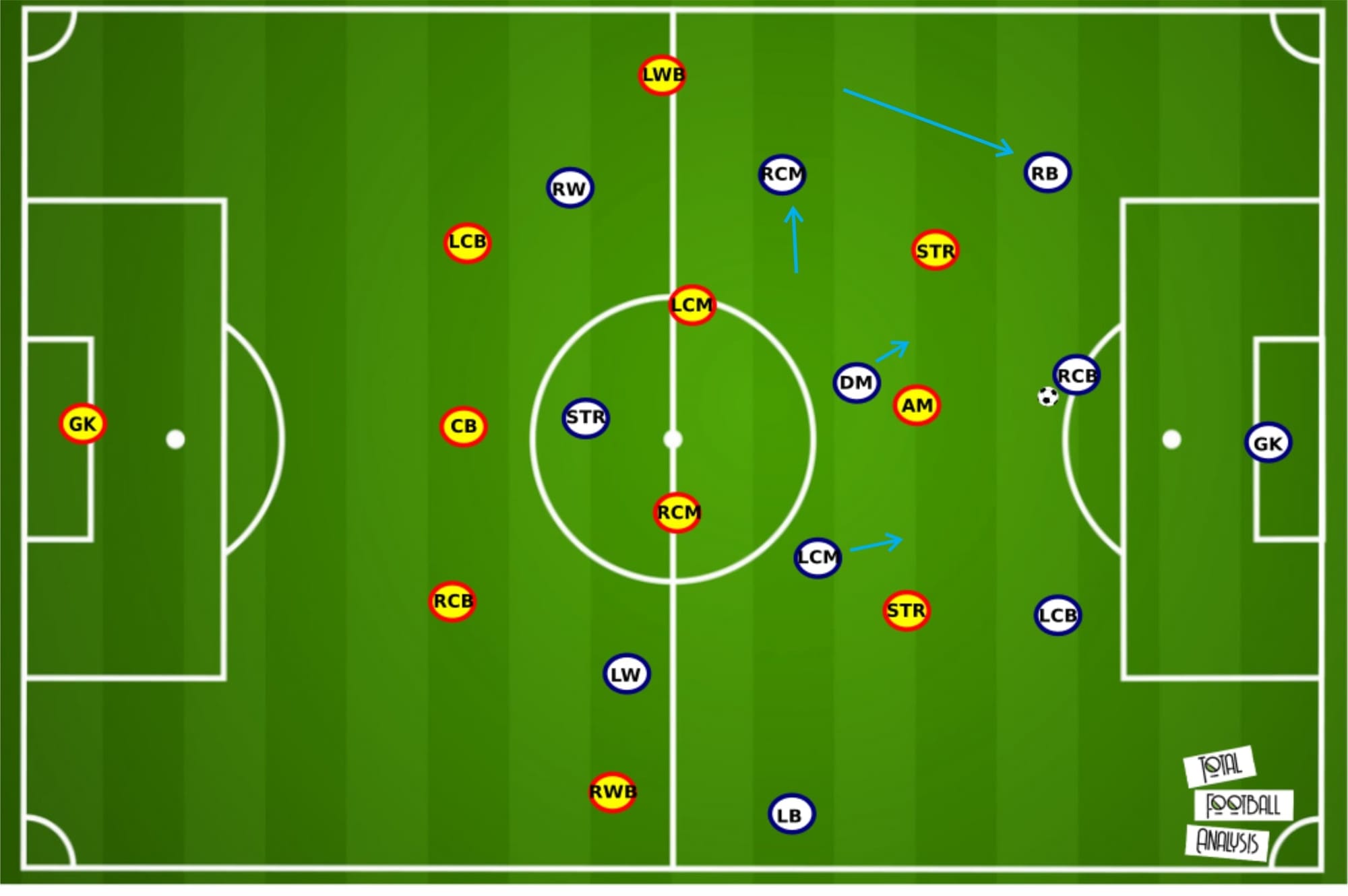
In the image above you can see both PSG’s initial shape in the build-up as well as Lens’ pressing shape.
As you can see, PSG looked to create a back-three in the build-up. To do so, they seemed to do it either by having one of the full-backs (usually the right-back, Kurzawa) moving inside and staying deep, temporarily playing as a wide centre-back (as in the image above) or having the defensive midfielder drop and sit in between the two centre-backs in this game.
In the image above, with the right-back staying deep and tucking in, the right central midfielder would move towards the flank in order to provide width. Meanwhile, the defensive midfielder and left central midfielder would look to actively move around, looking to get out of Lens’ attackers’ cover shadow and open up space as well as supporting angles. As usual, PSG’s wingers tended to sit narrower and occupy the half-spaces rather than near the touchline.
With Lens looking to block PSG’s access in central areas, Tuchel’s side were forced to move the ball towards the flank in order to get past Lens’ first line of pressure. There were several ways that they used in the build-up to get past Lens’ pressure. Below is the first example.
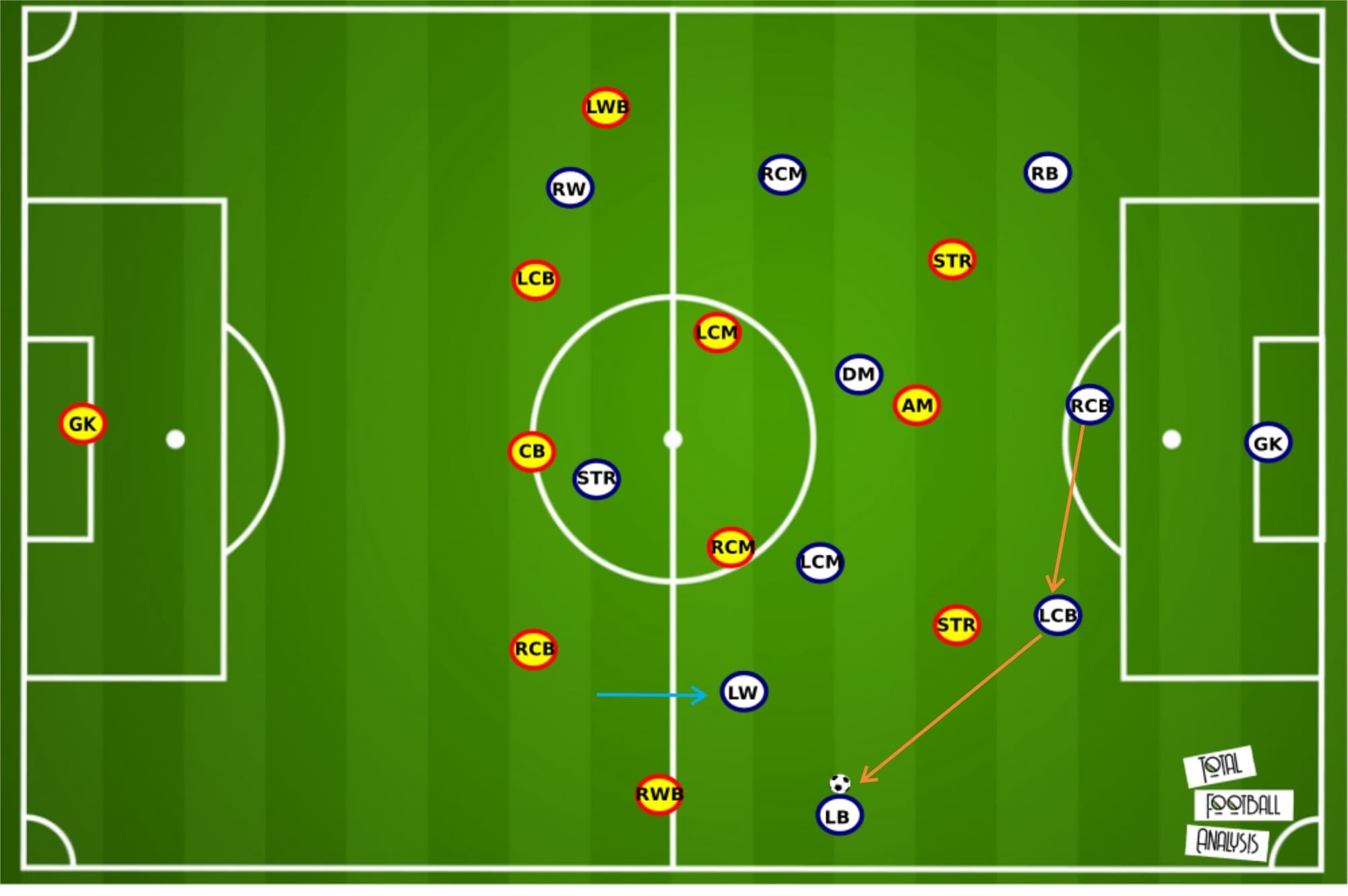
Above is one of the several ways that PSG used to exit Lens’ pressure and progress forward. As can be seen, the ball was moved from the middle to the wide centre-back and then passed again towards the full-back who was usually not tightly marked by Lens’ wing-back. Upon receiving the pass, the opposing wing-back would immediately press the man in possession. Meanwhile, the winger tended to drop deep to offer support and combine on the flank.
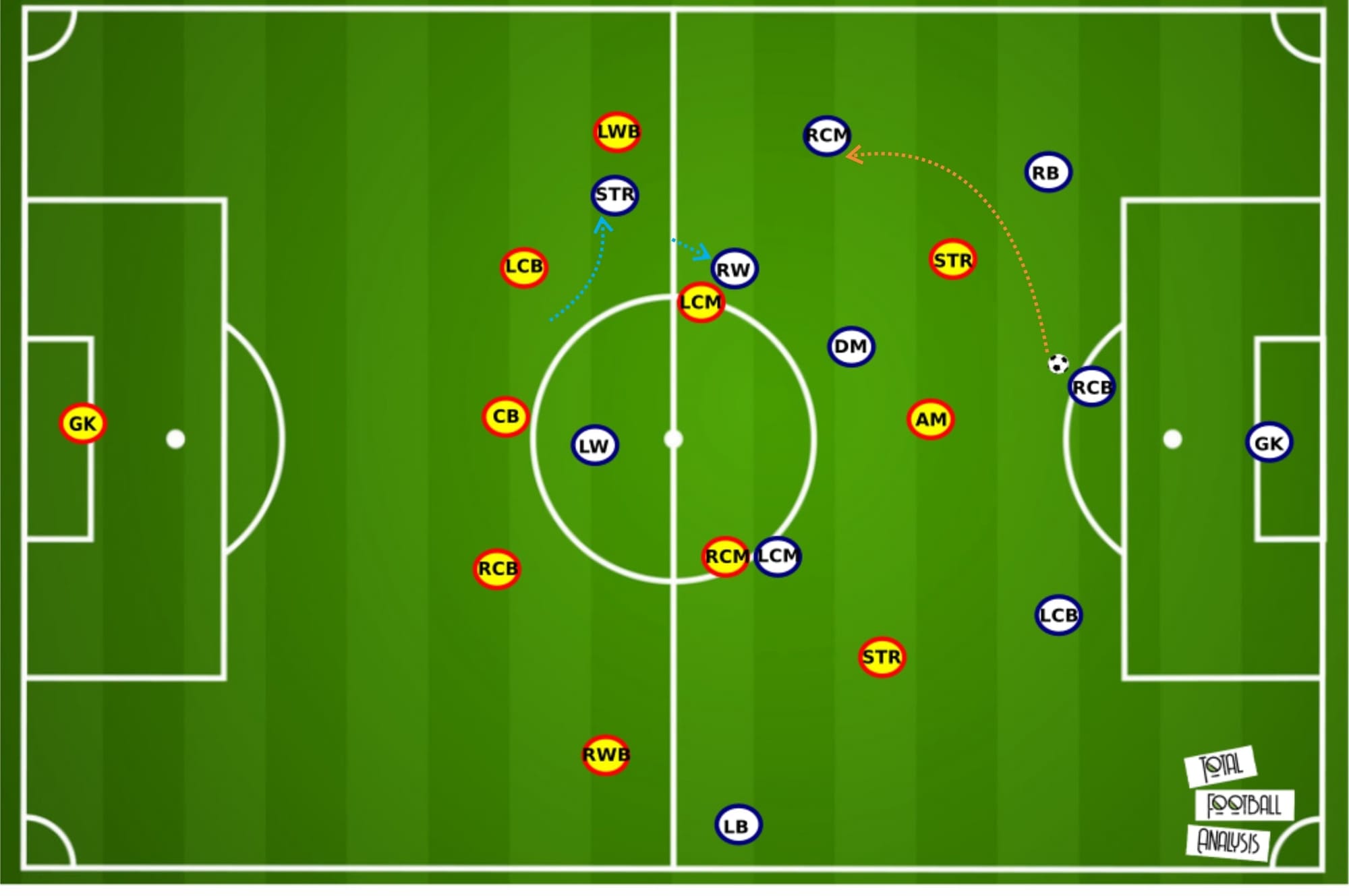
Above is another pattern that can be seen in PSG’s build-up. As mentioned earlier, PSG were very flexible and fluid in their game. Players were given a lot of freedom when it comes to movements and a lot of time they can be seen swapping positions. In the image above, for example, the PSG striker can be seen moving towards the right flank while the right-winger moved deeper. By doing so, PSG have created an overload on the right side of the field.
With the opposing left wing-back being occupied by PSG’s striker and the opposing left central midfielder being occupied by PSG’s right-winger, the right central midfielder was left free. The man in possession then could distribute the ball safely to him either via chipping it or giving it to the right-back first.
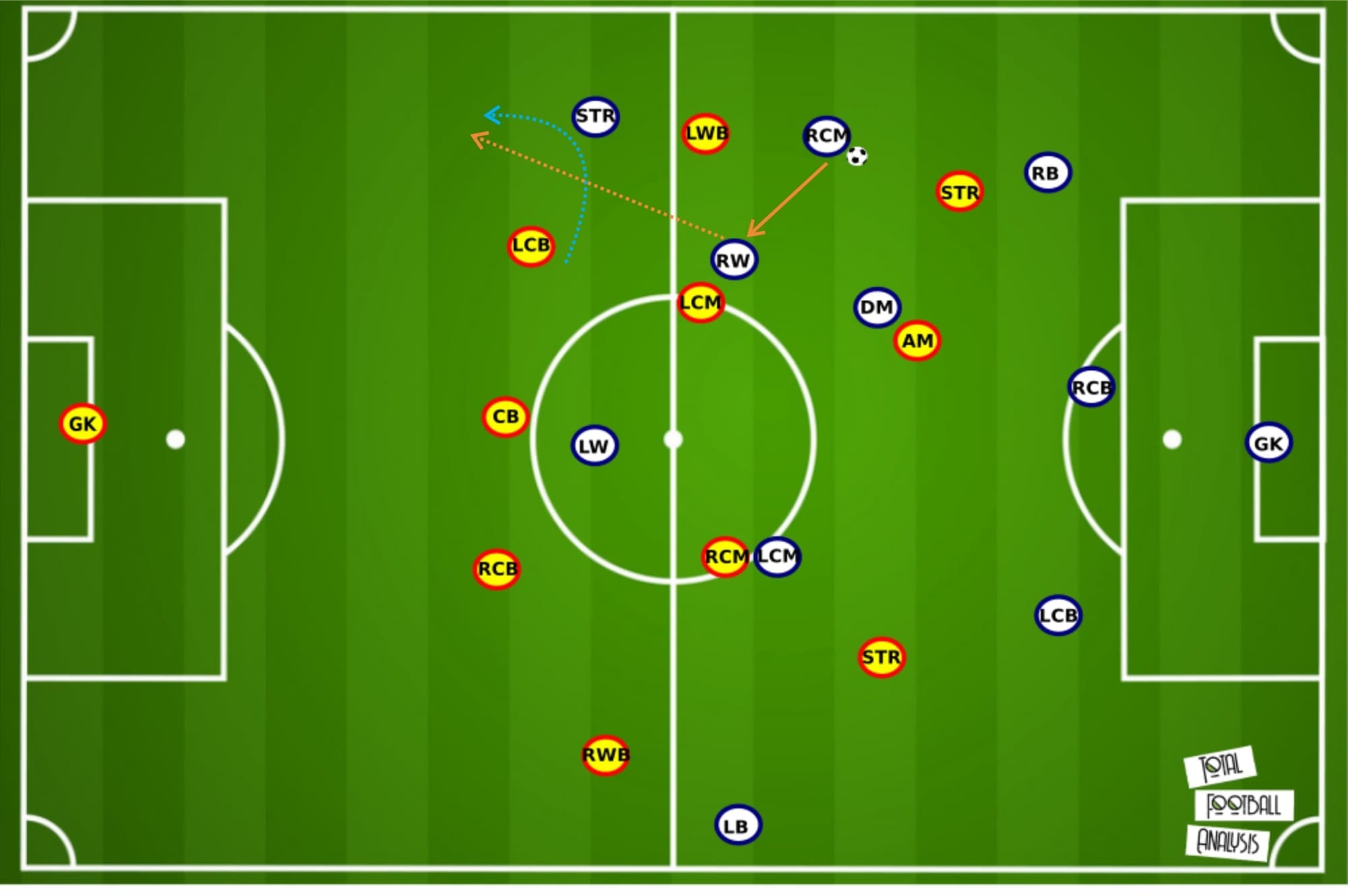
Against Lens, PSG were forced to be quicker in moving the ball due to Lens’ aggression and intensity in pressing. They were allowed less time and space and consequently, fewer touches on the ball. This forced them to be slightly more straightforward than usual.
PSG looked to take advantage of Lens’ man-oriented marking by making fluid collective movements as well as third-man mechanisms as can be seen in the image above. Upon receiving the ball, the right central midfielder of PSG (who’s being closed down by Lens’ left wing-back) then passed the ball to the dropping right-winger, who in turn, played a first-time pass towards the striker who made an outward run.
This didn’t happen very often though. PSG seemed to be keener on keeping possession and working the ball patiently rather than being more direct against their opponent although Lens occasionally showed signs of struggling to keep up with PSG when they’re breaking forward quickly and taking more risks.
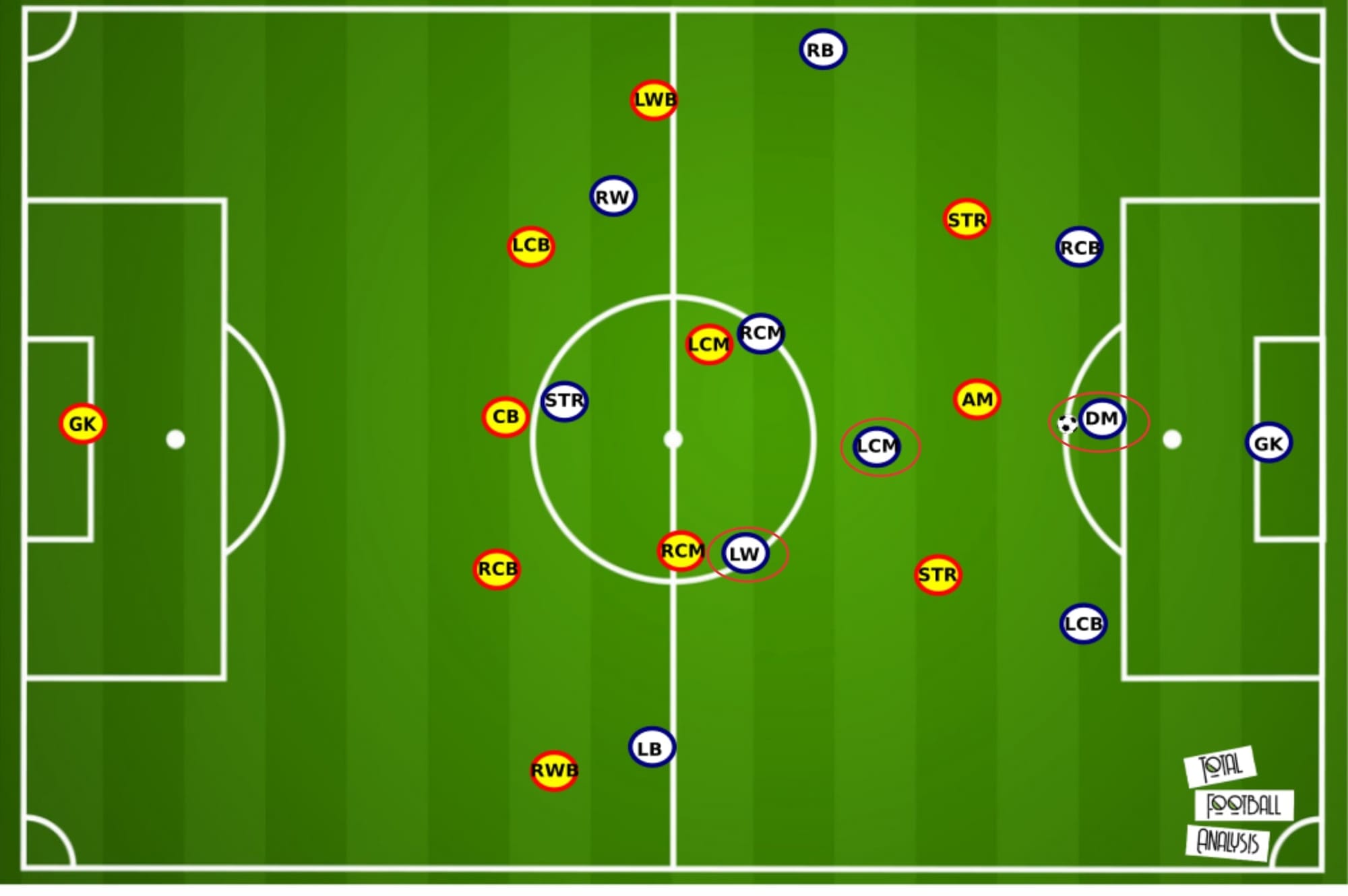
Above is another way of playing from the back by PSG. Instead of having the right-back tucked in, the defensive midfielder dropped into in between the two centre-backs, again to create a back-three. In order to get out of Lens’ pressure, PSG looked to create positional advantages as well. Above, for example, the left-winger dropped down and took the spot of the left central midfielder while the left central midfielder took the defensive midfielder’s spot. By taking the spot of the left central midfielder, the left-winger would occupy the opposing right central midfielder, freeing up the left central midfielder from any marker. The left central midfielder could then receive the ball in between the first and second line of pressure and continue the build-up from there.
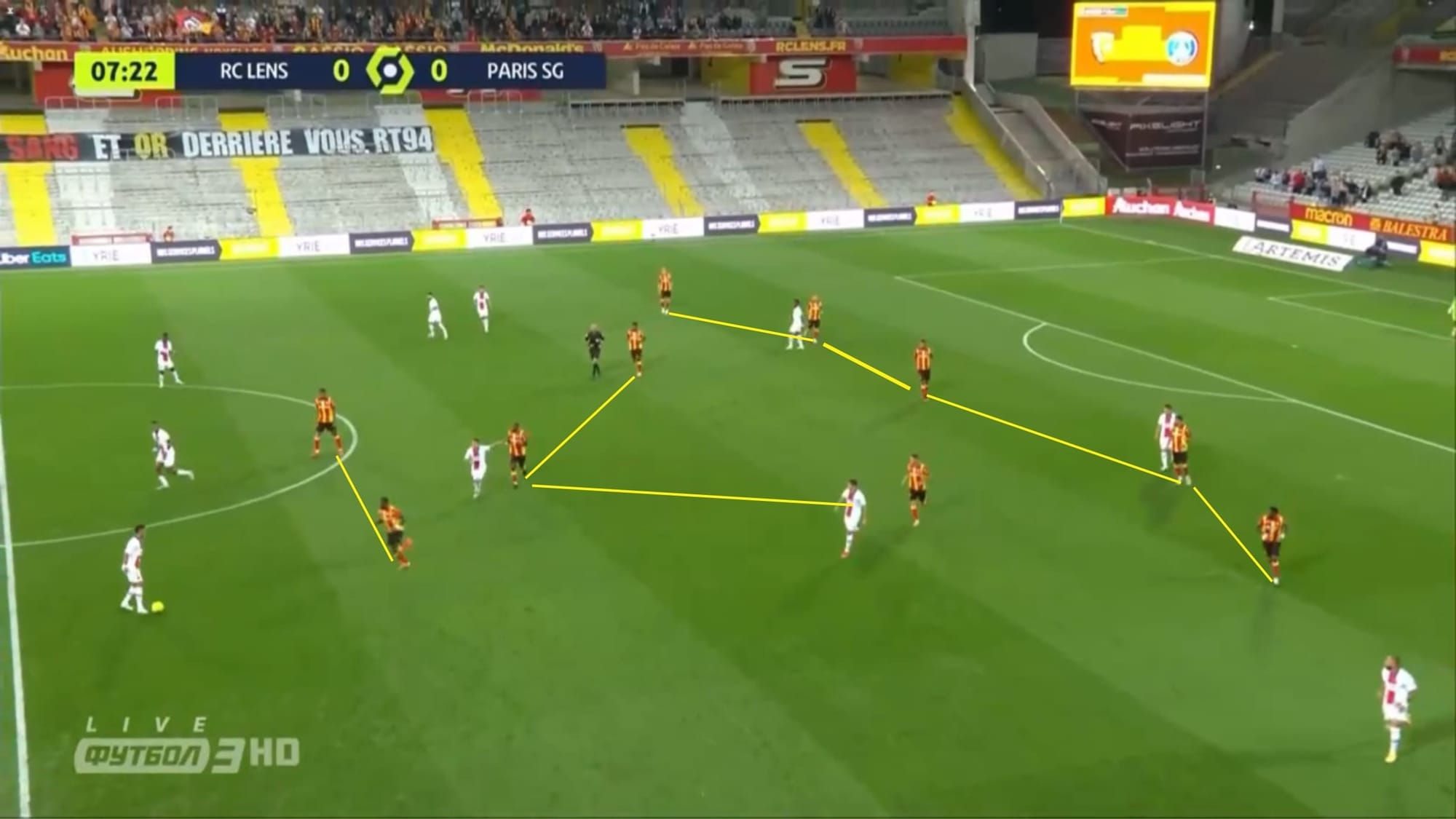
Lens, meanwhile, were heavily man-oriented in defence. Players tended to stick tight to their respective opponent and would follow them closely. They tended to defend in a 5-3-2 shape which may turn into a 5-2-3/3-4-3 shape due to their man-oriented approach. Haise’s side looked to defend with a high block and press PSG from the get-go. However, PSG were often still able to play their way out from the back and bypass their first line of pressure due to their creative variations of build-up pattern.
Lens, however, were quick to set-up a mid/low-block if PSG managed to get past their first line of pressure.
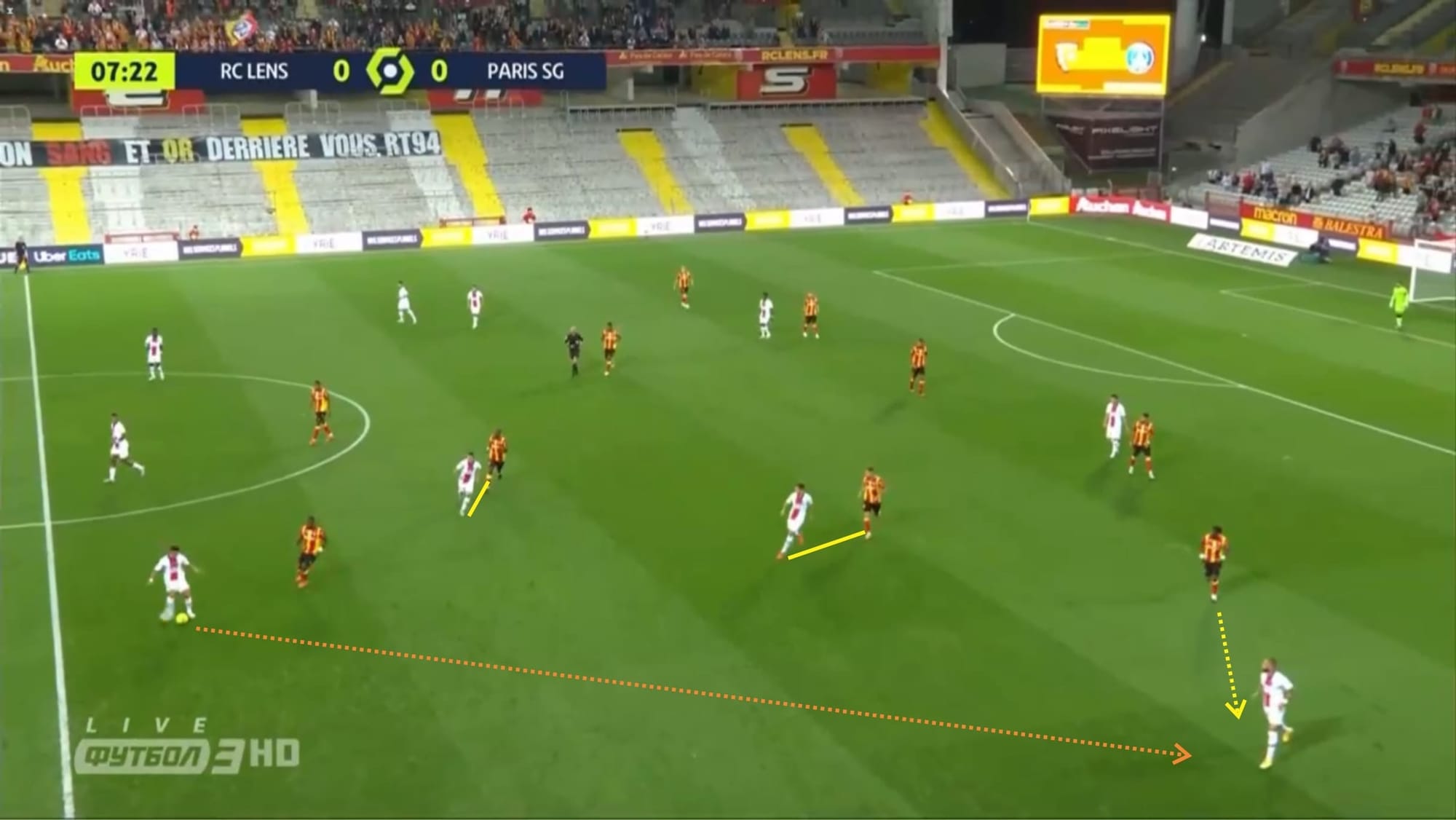
Lens’ main aim was to block access to central areas. As you can see above, they have a compact and narrow block. They didn’t give Tuchel’s side a lot of space to exploit in the middle. Aside from that, players in central areas were usually tightly marked, making it even more difficult to play through the middle.
However, Lens usually deliberately left some space on the flank. By blocking and marking other options whilst also purposely allowing space in certain areas, Lens were looking to force or lure the opposing team into making a predictable action.
In the image above, for example, Lens’ left wing-back tended to only loosely mark the opposing winger, making the opposing ball carrier think that it would be safe to pass the ball wide. However, the wing-back would quickly close him down upon seeing the ball being played.
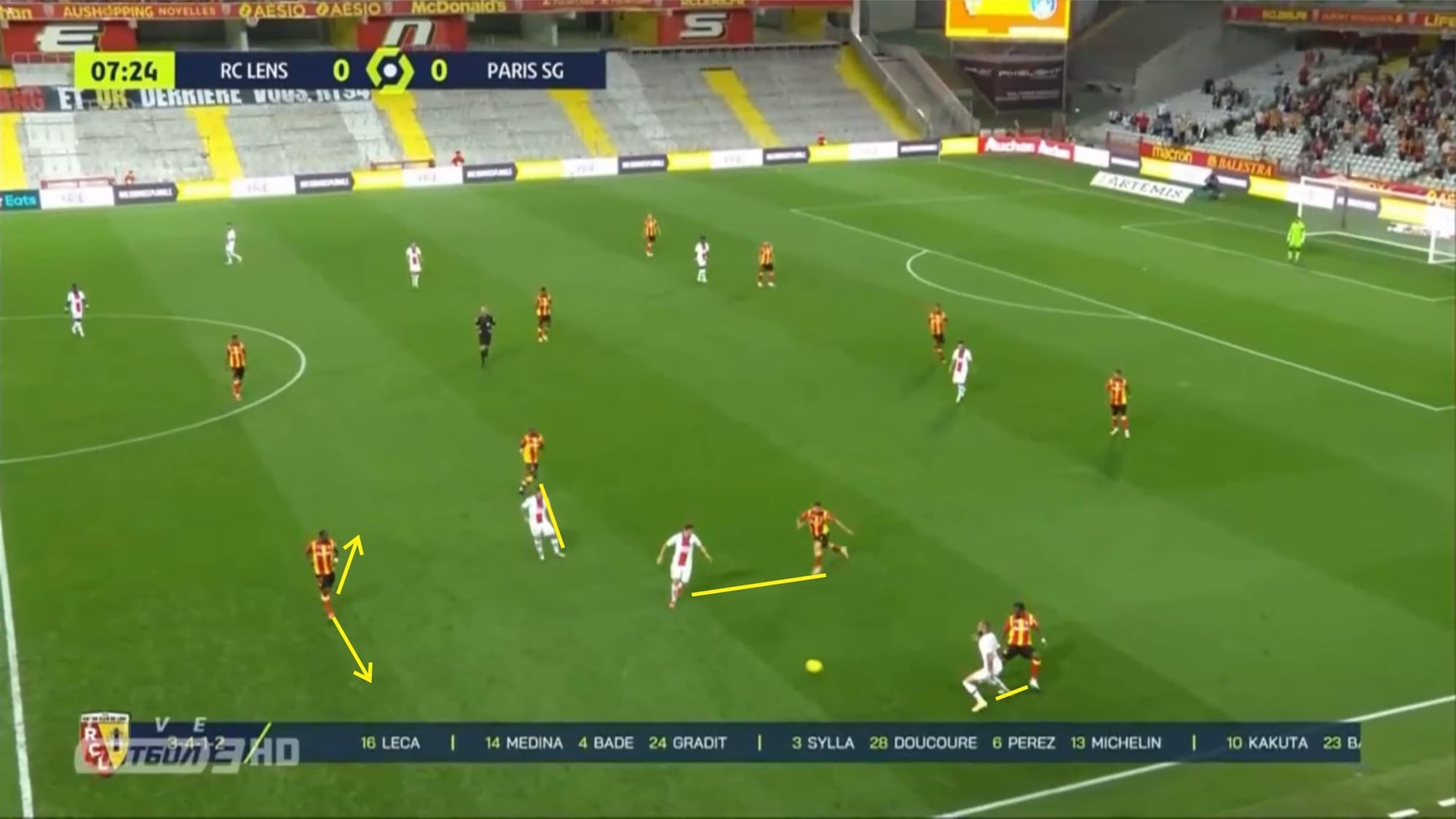
As a result, above you can see that Lens successfully put PSG in their pressing trap and ultimately regaining possession.
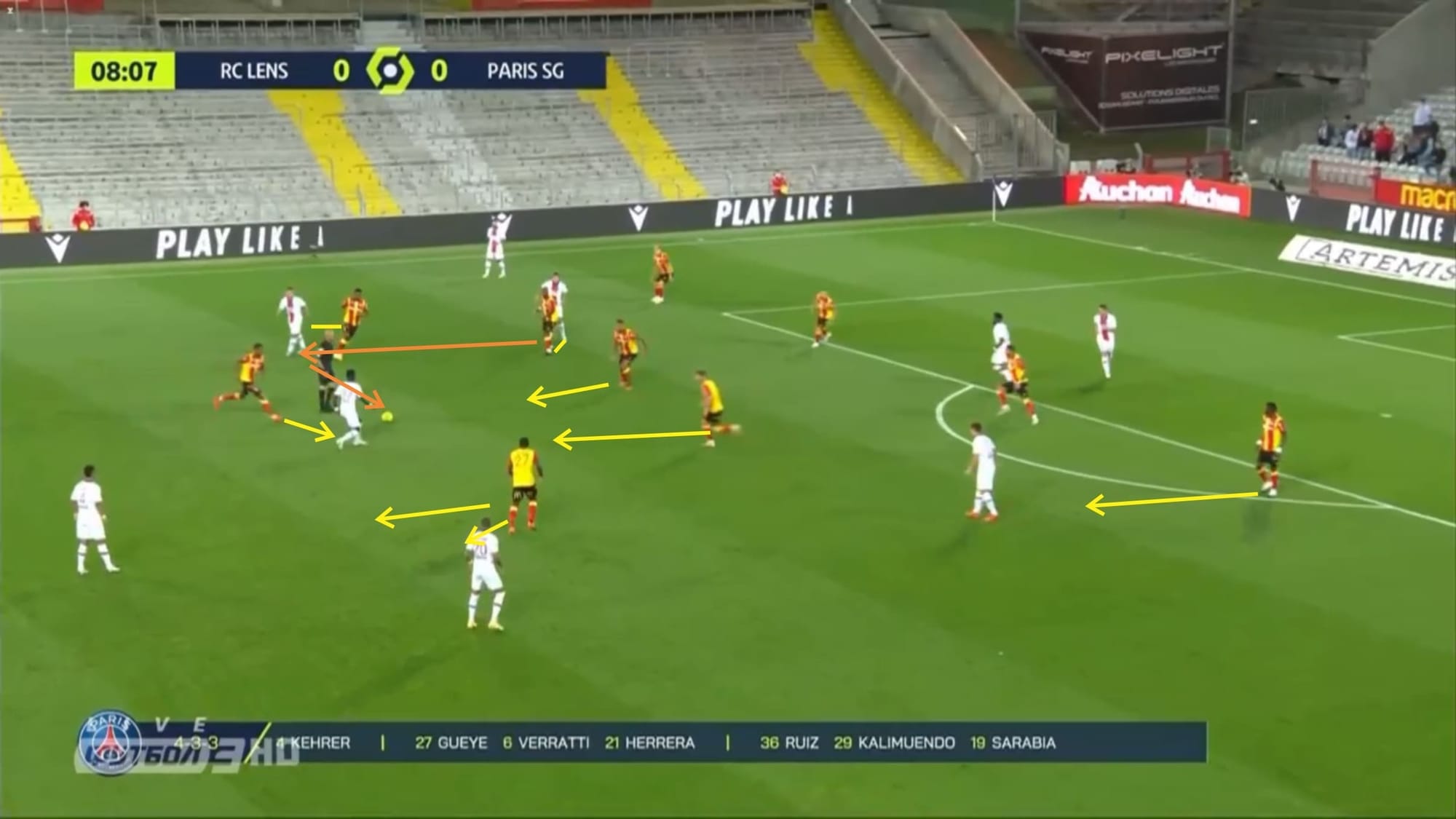
Aside from their wide pressing traps, Lens also set up central pressing traps which was usually triggered if a pass is played towards a player in between two lines of defence. Above you can see that Lens’ players immediately collapsed onto the ball and swarmed the opposing ball-carrier.
In this match, Lens, who were one of the most aggressive (and most effective) pressing teams in Ligue 2 last season once again showed how dangerous they can be in advanced areas not only due to their fast and precise attacks but also their highly intense pressing and counter-pressing. PSG struggled a lot against Lens’ aggressive press. In fact, Lens’ goal in the game were as a result of their aggressive pressing.
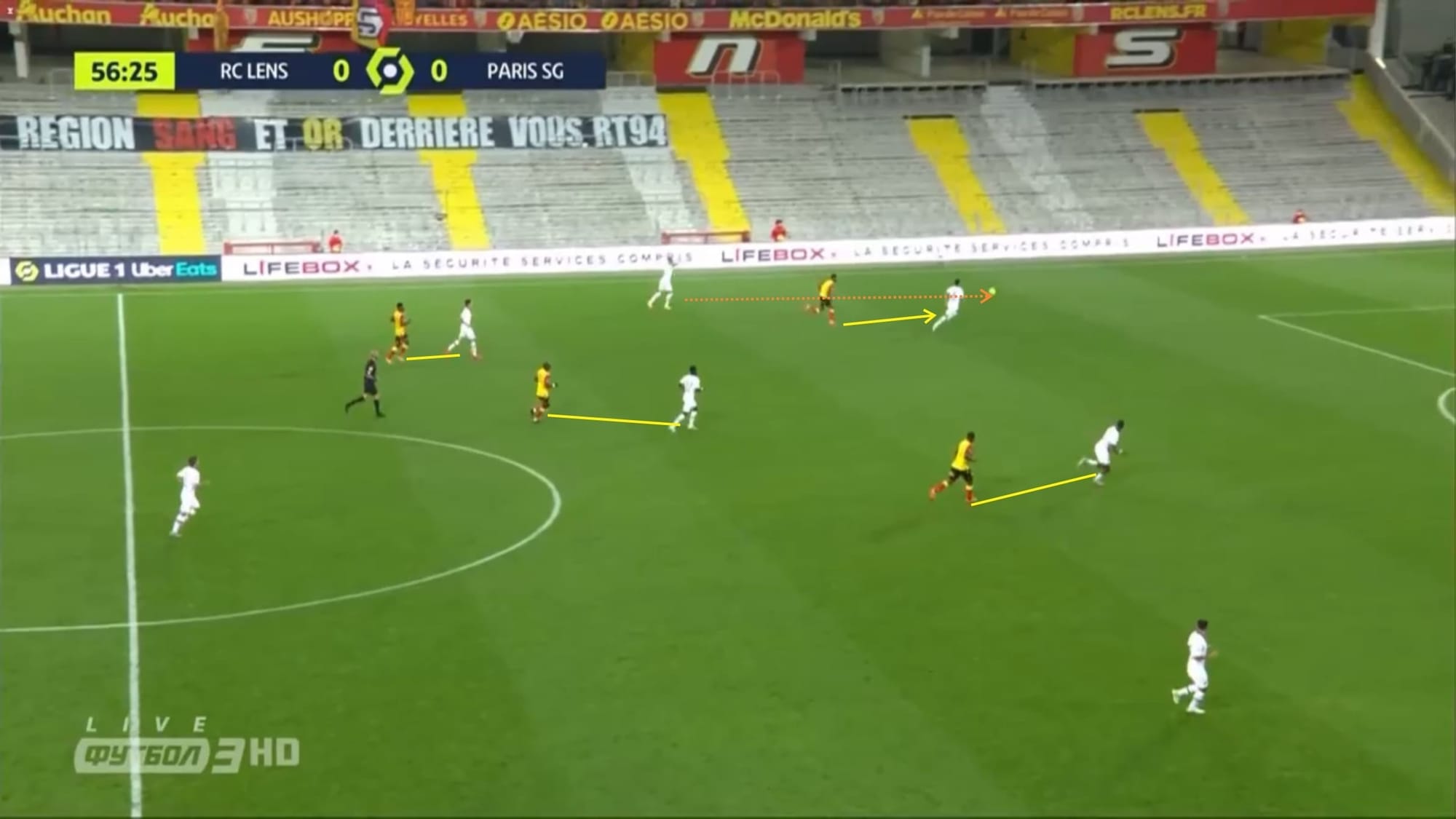
The image above is the situation preceding Lens’ goal. Leca distributed the ball with a long goalkick towards Banza on the left side of the field. Kurzawa got to the ball first and originally wanted to direct the ball towards the right centre-back (Kehrer) but didn’t make clean contact with the ball. The poor pass immediately triggered Lens to push forward and pile more pressure on PSG.
As can be seen above, Kehrer came to collect the ball while being pressed by Banza who also kept Kurzawa in his shadow cover, forcing Kehrer to pass the ball back to the goalkeeper due to the lack of safe options nearby.
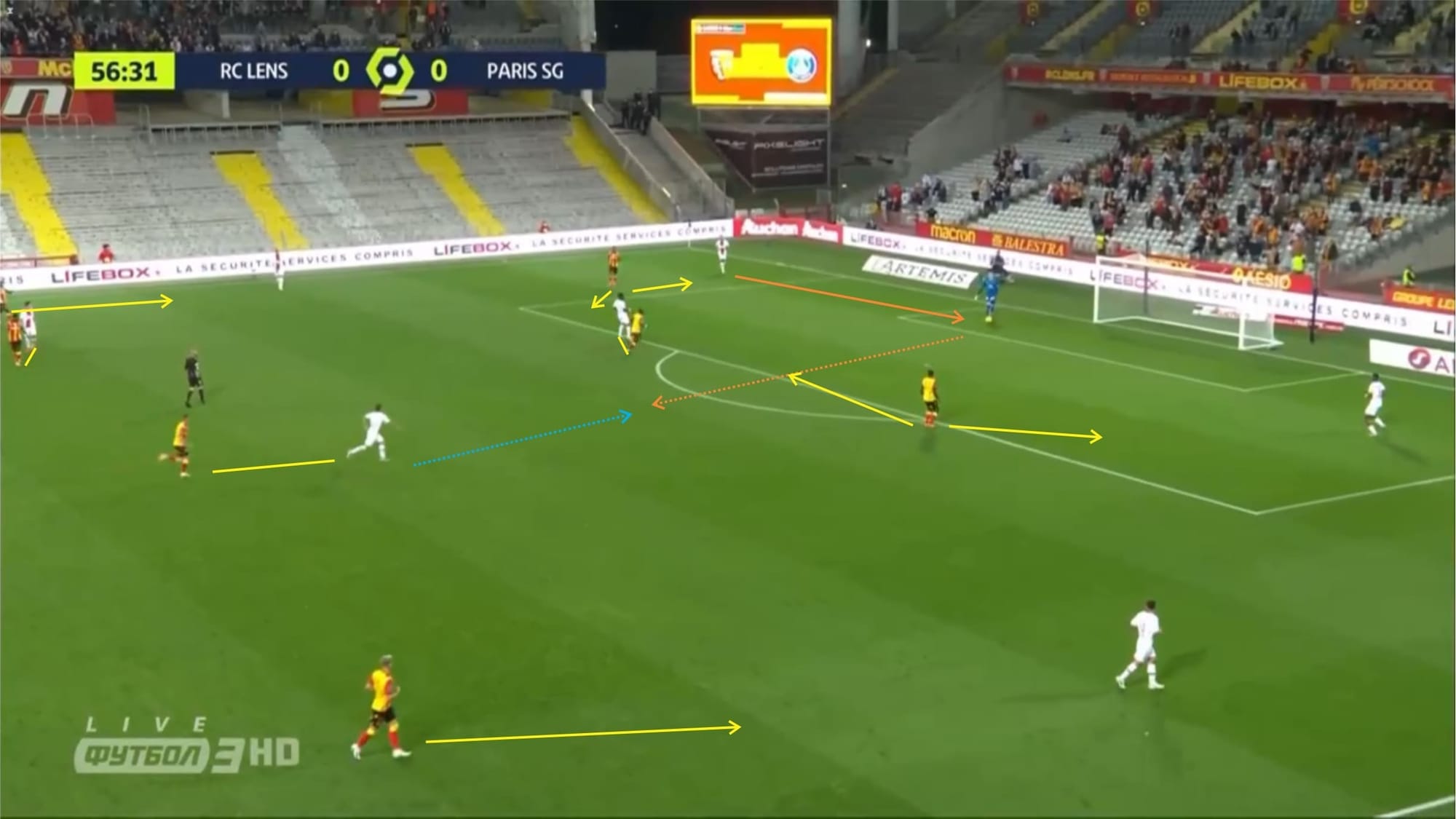
In the image above, Bułka received the ball. Usually in this situation, Bułka – who clearly lacked ball-playing ability and seemed a bit vulnerable when in possession and under pressure – would immediately clear the ball away rather than taking a risk. However, surprisingly, the Polish youngster decided to play a pass towards Marco Verratti (blue arrow).
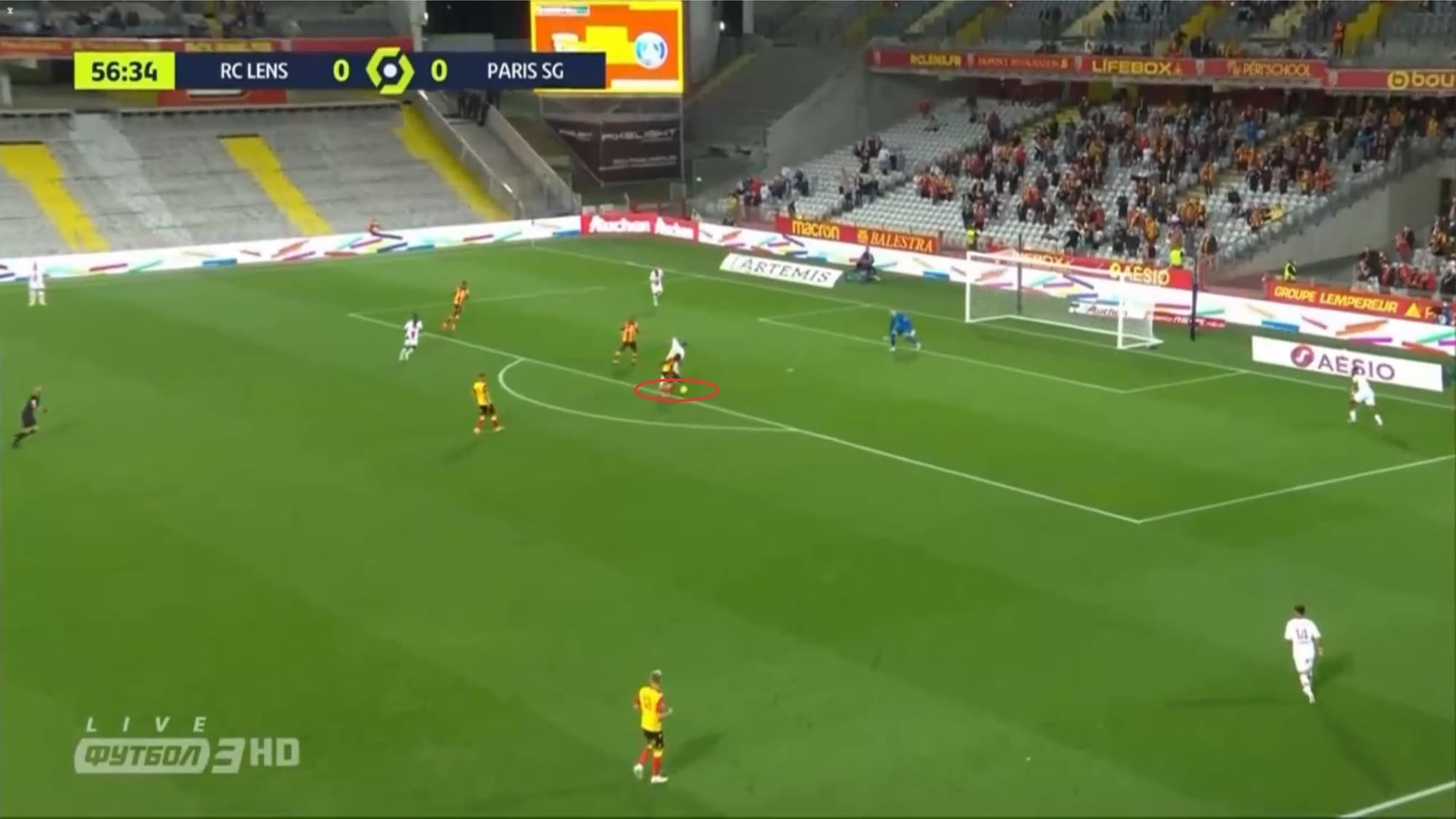
His pass wass too weak and Ganago managed to intercept it. The former Nice striker then blasted the ball into the top left corner of the net, nowhere near Bułka’s reach. And that’s the only goal of the game.
Lens seemed to create their chances and pose threat in advanced areas mostly due to their aggressive and intense high pressing and rarely from a clean vertical build-up. They’d often lose possession in advanced areas, press, win the ball back, and hit back when the opposing team were most vulnerable.
Conclusion
It was perhaps a rather surprising result but frankly thoroughly deserved for Lens. The home side may be dominated possession-wise but they were extremely solid and organized defensively. Even with very little possession, Haise’s side were much more effective and were still able to pose more threat in advanced areas compared to the visiting team.
Relying a lot on intensity, aggression, verticality, and discipline, Lens were able to overcome PSG in a rather exciting encounter. Meanwhile, PSG, who were without the presence of Mbappé, Neymar, Di María, and Icardi were impotent up front. They lacked creativity and sharpness in advanced areas and they rarely create good goalscoring chances.
Lens would face fellow promoted side Lorient in their next fixture whilst PSG would host Marseille in a Le Classique derby in their next fixture. Both newly-promoted sides have done decently so far in the season with both collecting three points from one win and one loss. On the other side, Tuchel and his men would certainly be eager to bounce back from their loss against Lens by securing three points against their arch-rivals.





Comments